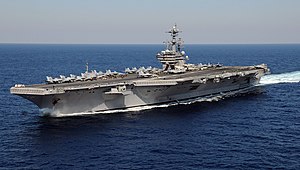
Back يو إس إس جورج بوش الأب Arabic USS «Джордж Буш» (CVN-77) BE-X-OLD ইউএসএস জর্জ এইচ.ডব্লিউ. বুশ Bengali/Bangla یو ئێس ئێس جۆرج ئێج. دەبلیوو. بوش CKB USS George H. W. Bush (CVN-77) Czech USS George H.W. Bush (CVN-77) CV USS George H. W. Bush (CVN-77) Danish USS George H. W. Bush (CVN-77) German USS George H. W. Bush (CVN-77) Spanish یواساس جورج اچ. دبلیو. بوش Persian
 USS George H.W. Bush in January 2011
| |
| History | |
|---|---|
| Name | George H.W. Bush |
| Namesake | George H. W. Bush |
| Ordered | 26 January 2001 |
| Awarded | 26 January 2001 |
| Builder | Northrop Grumman Newport News[1] |
| Cost | $6.2 billion[2] |
| Laid down | 6 September 2003[1] |
| Sponsored by | Dorothy Bush Koch[1] |
| Christened | 7 October 2006 |
| Launched | 9 October 2006 |
| Commissioned | 10 January 2009[2] |
| Homeport | Norfolk |
| Identification |
|
| Motto | Freedom at Work |
| Nickname(s) | Avenger |
| Status | in active service |
| Badge |  |
| General characteristics | |
| Class and type | Nimitz-class aircraft carrier |
| Displacement | 102,000 long tons (114,000 short tons)[3][4] |
| Length |
|
| Beam |
|
| Draft |
|
| Propulsion |
|
| Speed | 30+ knots (56+ km/h; 35+ mph)[9] |
| Range | Unlimited distance; 20–25 years |
| Complement |
|
| Sensors and processing systems |
|
| Electronic warfare & decoys |
|
| Armament |
|
| Armor | 2.5 in (64 mm) Kevlar over vital spaces[7] |
| Aircraft carried | 90 fixed wing and helicopters |
USS George H.W. Bush (CVN-77) is the tenth and final Nimitz-class supercarrier of the United States Navy. She is named for the 41st President of the United States and former Director of Central Intelligence George H. W. Bush, who was a naval aviator during World War II. The vessel's callsign is Avenger, after the TBM Avenger aircraft flown by then-Lieutenant George H. W. Bush in World War II. Construction began in 2003 at Northrop Grumman, in Newport News, Virginia and was completed in 2009 at a cost of $6.2 billion. Her home port is Naval Station Norfolk, Virginia.
- ^ a b "Aircraft Carrier Named the USS George H.W. Bush Commissioned". Fox News. 10 January 2009. Archived from the original on 21 October 2012. Retrieved 2 June 2009.
- ^ Polmar, Norman (2004). The Naval Institute guide to the ships and aircraft of the U.S. fleet. Naval Institute Press. p. 112. ISBN 978-1-59114-685-8. Retrieved 26 September 2016.
nimitz class displacement
- ^ "CVN-68: NIMITZ CLASS" (PDF).
- ^ Kuperman, Alan; von Hippel, Frank (10 April 2020). "US Study of Reactor and Fuel Types to Enable Naval Reactors to Shift from HEU Fuel". International Panel on Fissile Materials. Archived from the original on 5 October 2021. Retrieved 26 February 2022.
- ^ Hanlon, Brendan Patrick (19 May 2015). Validation of the Use of Low Enriched Uranium as a Replacement for Highly Enriched Uranium in US Submarine Reactors (PDF) (MSc). Massachusetts Institute of Technology. Archived (PDF) from the original on 9 October 2021. Retrieved 26 February 2022.
- ^ Fontenoy, Paul E. (2006). Aircraft carriers: an illustrated history of their impact. ABC-CLIO Ltd. p. 349. ISBN 978-1-85109-573-5.
- ^ Gibbons, Tony (2001). The Encyclopedia of Ships. London, United Kingdom: Amber Books. p. 444. ISBN 978-1-905704-43-9.
© MMXXIII Rich X Search. We shall prevail. All rights reserved. Rich X Search